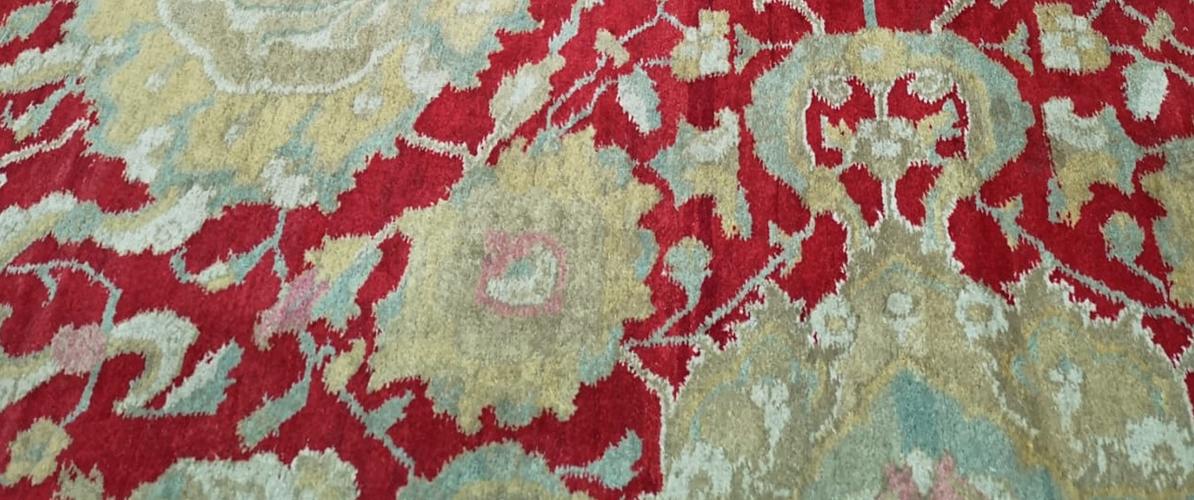-
A large rectangular red-ground woollen carpet, woven with scattered cream, blue and red flowers and cartouches, within a border of abstract floral ovals on a blue ground. Made by inmates of the Agra gaol, India.
Gaol carpet manufacture was widespread in late-nineteenth century India, encouraged by colonial officials and prison authorities who sought productive and profitable activities for inmates.
The industry was intended both to discipline and reform prisoners, giving them marketable skills for use on release while generating income for the penal institution. From the 1850s, prison-made carpets featured regularly at international and domestic exhibitions, as well as in Indian museums. Largely reproducing historic designs, convict weaving formed part of a broader effort to revive ‘traditional’ Indian craft, championed by artists and officials such as George Birdwood at the India Office and Lockwood Kipling at the Mayo School of Arts in Lahore. European designers praised carpets like these for their delicate ornamentation and harmonious colours.Provenance
This carpet was made in Agra, India. The Viceroy of India at the time, Lord Lansdowne, saw the carpet being made at Agra gaol in November 1893. It arrived at Windsor Castle by rail in an immense roll and was installed in the Waterloo Chamber on 1 October 1894, where it has remained ever since.
A.G. Seymour, Clerk of Accounts at Windsor Castle from 1893-1930, recorded the installation of the carpet in his diary:
'Speaking of India reminds me of the arrival of the great Indian carpet on 1st October 1894. It was made at Agra and fitted to the Waterloo Gallery. On that October morning word was brought that at the G.W. Railway Station, they had for delivery an immense roll of carpet, and would we send down to determine how it could be delivered. It was found stretched across two railway trucks. It was a really gigantic roll, bound in long timber splints and weighing several tons. The firm who did our carriage, for there were no motors in those days, volunteered to tackle the job and we sent forty men to help. The great thing straddled over two lorries drawn by four horses and the men pulled with ropes, and so they started up the Castle Hill. It was a sight worth seeing, men and horses straining their utmost amid the shouts of those directing the operations.' (RA Add U278/59-61) -
Creator(s)
(nationality)Acquirer(s)
-
Medium and techniques
Wool
Measurements
23m x 12m (whole object)
Place of Production
Agra [Uttar Pradesh]

Search results
Start typing
- Home
- /
- Collection
- /
- Explore the Collection
- /
- Carpet
- /
Keep in touch
Sign up to e-mail updates for the latest news, exclusive events and 15% off in our online shop.
We will look after your data in accordance with our Privacy Notice.
Quick Links
The income from your ticket contributes directly to The Royal Collection Trust, a registered charity. The aims of The Royal Collection Trust are the care and conservation of the Royal Collection, and the promotion of access and enjoyment through exhibitions, publications, loans and educational activities.









